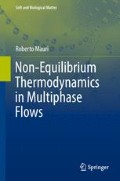Abstract
The Principle of Microscopic Reversibility was formulated by Richard Tolman (The Principles of Statistical Mechanics, Dover, New York, 1938) who stated that, at equilibrium, “any molecular process and the reverse of that process will be taking place on the average at the same rate”. Applying this concept to macroscopic systems at local equilibrium leads to the rule of detailed balances (Sect. 2.2) and then, assuming linear relations between thermodynamic forces and fluxes, to the formulation of the celebrated reciprocity relations (Sect. 2.3) derived by Lars Onsager in 1931, and the fluctuation-dissipation theorem, (Sect. 2.4) proved by Herbert Callen and Theodore Welton in 1951. In this chapter, this vast subject matter is treated with a critical attitude, stressing all the hypotheses and their limitations.
Access this chapter
Tax calculation will be finalised at checkout
Purchases are for personal use only
Notes
- 1.
Here and in the following, we use the same notation, x, to indicate both the random variable and the value that it can assume. Whenever this might be confusing, different symbols will be used.
- 2.
Note that, since Π(x i )=Π(ϵ i x i ), then 〈x i 〉=ϵ i 〈x i 〉, implying that all odd variables have zero stationary mean.
- 3.
In most of the literature, x- and y-variables are generally referred to as α- and β-variables.
- 4.
- 5.
As shown in [10], when fluxes and forces are not independent, but still linearly related to one another, there is a certain arbitrariness in the choice of the independent variables, so that at the end the phenomenological coefficients can be chosen to satisfy the Onsager relations.
- 6.
- 7.
This process is sometimes called Knudsen effusion.
- 8.
The same result can be obtained assuming that the constant thermodynamic force X 0 is suddenly turned on at t=0, so that for long times the system will have a non-zero position of stable equilibrium, x F =−g −1⋅X 0. In that case, redefining the random variable x as x F −x, we find again Eq. (2.41).
- 9.
This is a somewhat simplified analysis. For more details, see [5].
- 10.
Here, when the applied force F is constant, the equilibrium state will move from 〈x〉=0 to 〈x〉=F/(gkT).
- 11.
This is clearly equivalent to the Onsager regression hypothesis. Note that here and in the following x denotes the fluctuation (x−〈x〉).
References
Callen, H.B., Greene, R.F.: Phys. Rev. 86, 702 (1952)
Callen, H.B., Greene, R.F.: Phys. Rev. 88, 1387 (1952)
Callen, H.B., Welton, T.A.: Phys. Rev. 83, 34 (1951)
Casimir, H.B.G.: Rev. Mod. Phys. 17, 343 (1945)
de Groot, S.R., Mazur, P.: Non-Equilibrium Thermodynamics. Dover, New York (1962), Chap. VIII.4
Einstein, A.: Ann. Phys. (Berlin) 17, 549 (1905)
Green, M.S.: J. Chem. Phys. 22, 398 (1954)
Kubo, R.: J. Phys. Soc. Jpn. 12, 570 (1957)
Marconi, U.M.B., et al.: Phys. Rep. 461, 111 (2008)
Meixner, J.: Rheol. Acta 12, 465 (1973)
Nyquist, H.: Phys. Rev. 32, 110 (1928)
Onsager, L.: Phys. Rev. 37, 405 (1931)
Onsager, L.: Phys. Rev. 38, 2265 (1931)
Tolman, R.C.: The Principles of Statistical Mechanics, p. 163. Dover, New York (1938), Chap. 50
van Kampen, N.G.: Stochastic Processes in Physics and Chemistry. North-Holland, Amsterdam (1981), Chap. VIII.8
Author information
Authors and Affiliations
Rights and permissions
Copyright information
© 2013 Springer Science+Business Media Dordrecht
About this chapter
Cite this chapter
Mauri, R. (2013). Microscopic Reversibility. In: Non-Equilibrium Thermodynamics in Multiphase Flows. Soft and Biological Matter. Springer, Dordrecht. https://doi.org/10.1007/978-94-007-5461-4_2
Download citation
DOI: https://doi.org/10.1007/978-94-007-5461-4_2
Publisher Name: Springer, Dordrecht
Print ISBN: 978-94-007-5460-7
Online ISBN: 978-94-007-5461-4
eBook Packages: Physics and AstronomyPhysics and Astronomy (R0)

